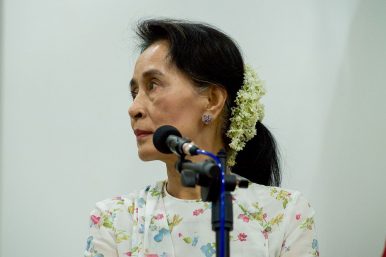A closer look at the move and what it may mean for the country’s politics.
January 30, 2019
THE DIPLOMAT
By Prashanth ParameswaranJanuary 30, 2019
 |
| Image Credit: Wikimedia Commons |
On Tuesday, Myanmar’s parliament voted to create a new committee to propose amendments to the country’s military-enacted constitution, formally putting the contentious issue of constitutional change on the agenda for the first time since historic elections brought to power the country’s opposition led by Aung San Suu Kyi three years ago.
The idea of constitutional change in Myanmar itself is far from new. But understanding the context for its reemergence as well as its potential impact is nonetheless important within the context of the National League for Democracy (NLD’s) position within the country’s broader politics heading into elections expected in 2020.
Myanmar’s latest constitution, the country’s third which was drafted in 2008 by the-then ruling junta, has long been under scrutiny for a whole series of reasons. But much of the international accounts of constitutional change have largely focused on provisions that bar Suu Kyi from the presidency because she has family who are foreign citizens and hand the military an effective veto in the legislature with it retaining 25 percent of legislative seats.
Upon coming to power in 2016, the NLD, led by Suu Kyi, had pledged to amend some of these provisions as part of wider constitutional change. And this week, for the first time, the NLD appeared to be moving towards actualizing this push for constitutional change. The push began with a vote in parliament to create a committee to propose amendments to the constitution, which was proposed by the NLD on Tuesday and passed through the legislature thereafter.
The NLD’s renewed push for constitutional change is not surprising given the wider political context. The issue of constitutional change for the NLD had always been more of an issue of not if, but when and how. It is a high-visibility agenda item that was not only floated as an election promise for the party, but also personally important to Aung San Suu Kyi and her political position.
Furthermore, while the NLD had been treading carefully with the military since its election win, officials had suggested that following losses by the party in by-elections last November, the party would push harder on some of its earlier election promises to consolidate support. 2019 constitutes an important year to do exactly that, because Myanmar’s next election is expected sometime in 2020
However, the impact of proposed constitutional change pushed by the NLD is much less clear at this stage. To be sure, it is not without significance. Most clearly, the successful vote on the formation of a committee this week is important symbolically because it is one of several ways that the NLD can use the formal mechanisms of government to indicate a desire to move forward with this in spite of military disapproval.
But beyond that, it is difficult to say how this would be advanced as an agenda item and what its impact is likely to be. First, the obstacles remain significant. The formation of a committee to propose constitutional amendments only requires a simple majority, which explains why the NLD was able to get the votes necessary for this. But that does not change the fact that for any substantive constitutional changes to actually go through, it would still need to pass that above 75 percent threshold, which is unlikely with the military’s retention of 25 percent of legislative seats.
The military has also not been coy about voicing its displeasure. Even the vote to form a committee this week saw widespread disapproval from military lawmakers, including allegations of a misuse of the legislative process. Irrespective of the validity of those allegations, it reinforced the reality that moves for constitutional change could intensify civil-military tensions in Myanmar as the NLD attempts to realize its more contentious election promises.
Second, beyond the advancement of this as a general priority, is also far from clear exactly what the NLD has in mind in terms of constitutional change. The successful vote on a committee to propose amendments conveniently leaves unanswered at this stage the question of what exact amendments will be pursued, which is where much of the contestation actually lies.
That is important. While some of the constitutional changes that could be floated, such as on political appointments and power sharing mechanisms between the federal government and individual states, may be more palatable relatively speaking, others that touch on the military’s control in the legislature and Suu Kyi’s eligibility to hold the presidency are more controversial.
Third and finally, it bears noting that the actual impact of any constitutional change on the NLD’s standing in Myanmar is quite uncertain. While the idea of constitutional amendments does tap into popular sentiment that remains generally skeptical of the military, it does not get at some of the rising concerns about the NLD’s performance that have emerged in recent years across the board, including the lack of comprehensive economic reforms, a perceived failure to address ethnic issues, and some backsliding on rights.
Additionally, there is also a risk that movement toward constitutional change that is focused too much on Suu Kyi’s eligibility for office and the military’s position in politics relative to the NLD could actually exacerbate existing concerns that this is more about personal power or usual politicking rather than putting the country and the needs of the people first. Seen from this perspective, constitutional change could in fact be a double-edged sword for the NLD.
To be sure, since is still early days in this renewed constitutional change push, it is not surprising that some of the specifics remain unclear. But as the country’s politics heats up leading into elections expected in 2020, how the NLD advances this priority and the implications for it and governance in Myanmar more generally will continue to be important to watch.
SOURCE:

No comments:
Post a Comment